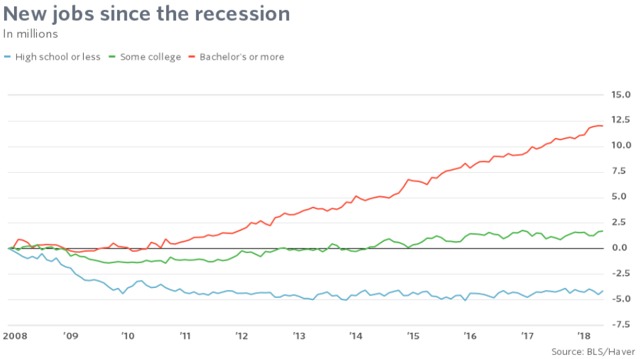Update: Labor Regulation and How It Harms Unskilled Labor
This summer I had the cover story in Regulation Magazine with my article "How Labor Regulation Harms Unskilled Workers: As government expands regulation of employers, they will increasingly turn to fewer, higher-skilled workers and automation." (pdf here). The article was not an academic project, but based on my own experience as a business owner who employs hundreds of workers in unskilled positions. The premise is that many labor regulations -- not just the minimum wage -- have the perverse effect of making it harder to employ unskilled labor while simultaneously providing incentives to shift hiring from unskilled labor to folks with college degrees, even for unskilled positions.
Because it was not an academic research project, I did not spend a lot of time researching labor statistics, but I can't resist posting this analysis which appeared on Seeking Alpha:
As the economy has grown, employment numbers for unskilled labor have flatlined, never recovering from the last recession. As I observed:
Fifteen years ago I started my current service business. I love my company and my employees. But if I had it all to do over again, I would never start a business based on employing unskilled labor. The government makes it too difficult, in far too many ways, to try to make a living employing unskilled workers. Given a new start, I would find a business with a few high-skill employees creating a lot of value.
And I don’t think I’m alone. In the 1950s, 1960s, and 1970s, there was a wave of successful large businesses built on unskilled labor (e.g., ServiceMaster, Walmart, McDonalds). Today, investment capital and innovation attention is all going to companies that create large revenues per employee with workers who have college educations and advanced skills. Only 4% of the employees at Apple, for example, have less than a college degree.
Even in large service-sector companies that employ unskilled labor, much of their investment today is in finding ways to reduce their reliance on that labor. I remember a number of years ago when the Chili’s restaurant chain started putting little electronic displays on their tables. At first the displays just showed advertising and I thought they were an annoying waste of space. But over time the chain began using the devices first to accept payment for one’s food and more recently to take food orders. They are progressively eliminating the need for most of their wait-staff. Every major restaurant chain is doing the same thing: investing in technology to eliminate unskilled workers. Why bother trying to figure out how to serve a rapidly evolving customer demand with workers who are limited by government in a hundred different ways in how and when they can labor? A website or iPad never sleeps, never sues, never needs a lunch break (let alone documentation of that break), never has to have overtime, and doesn’t have its labor taxed.
